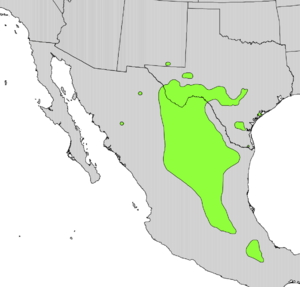Dermatophyllum secundiflorum facts for kids
Quick facts for kids Dermatophyllum secundiflorum |
|
|---|---|
 |
|
| Dermatophyllum secundiflorum flowers and leaves | |
| Scientific classification | |
| Kingdom: | |
| (unranked): | |
| (unranked): | |
| (unranked): | |
| Order: | |
| Family: | |
| Genus: | |
| Species: |
D. secundiflorum
|
| Binomial name | |
| Dermatophyllum secundiflorum (Ortega) Gandhi & Reveal
|
|
 |
|
| Natural range | |
| Synonyms | |
|
|
Dermatophyllum secundiflorum is a beautiful flowering shrub or small tree. It belongs to the pea family, known as Fabaceae. This plant is native to the southwestern United States, specifically Texas and New Mexico. You can also find it in Mexico, from Chihuahua and Coahuila down to Hidalgo, Puebla, and Querétaro.
People know this plant by several common names. These include Texas mountain laurel, Texas mescalbean, frijolito, and frijolillo.
Contents
Understanding the Plant's Name
Why it's Called Mescalbean
One of the common names for this plant is "mescalbean." However, it's important to know that this plant has no connection to Agave plants. Agave plants are used to make a drink called mezcal. The Texas mountain laurel is also not related to the peyote cactus.
Discovering the Texas Mountain Laurel
What the Plant Looks Like
The Texas mountain laurel is an evergreen plant. This means its leaves stay green all year round. Its leaves are made up of many smaller leaflets. These leaflets are thick and feel waxy when you touch them.
The plant usually does not grow very tall. It rarely has a perfectly straight trunk. Its bark is smooth, except on very old plants. It grows slowly, reaching about 15 ft (4.6 m) in height. Its crown, or the widest part of its branches, can spread up to 10 ft (3.0 m) wide.
Beautiful Flowers and Seeds
In March and April, the Texas mountain laurel produces amazing purple flowers. These flowers grow in large clusters and have a very strong, sweet smell. Many people say they smell like grape soda!
After the flowers bloom, the plant grows 4 in (10 cm) pods. Inside these pods, you will find deep orange seeds.
Where the Plant Grows
Its Natural Home
The Texas mountain laurel is very good at living in dry places. It thrives in arid (very dry) and semi-arid (somewhat dry) areas. However, it is most often found near rivers and streams. These areas are called riparian zones.
How People Use the Plant
Popular Ornamental Plant
The Texas mountain laurel is a very popular ornamental plant. People love to plant it in their gardens and yards. This is because of its beautiful, showy flowers and its bright orange seeds.
Historical Uses
The reddish wood from this plant could be useful for different things. However, it is not widely used for commercial purposes yet.
In the past, some Native American tribes used the beans from this plant. They used them in special traditional practices.
See also
 In Spanish: Frijolito de Texas para niños
In Spanish: Frijolito de Texas para niños

